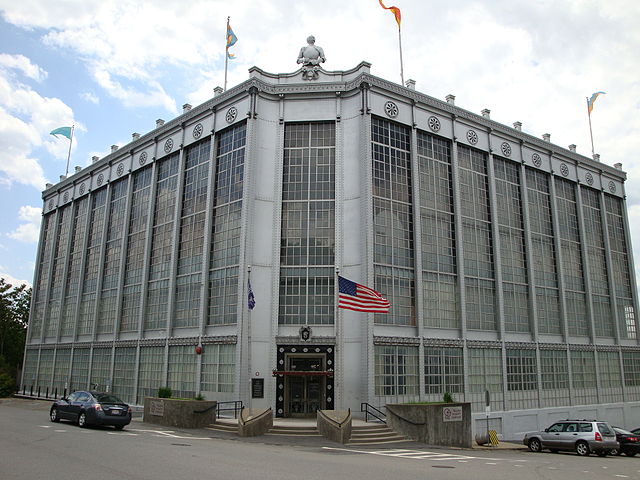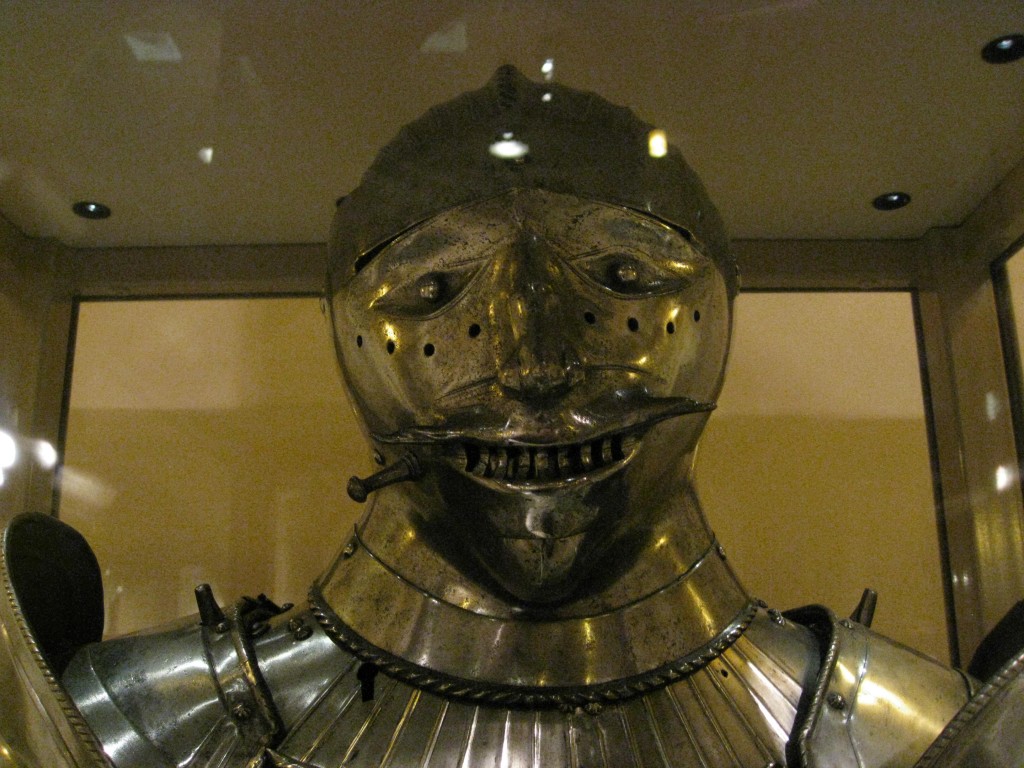Mixed into all of the “OMG! SNOW!” coverage on the local TV news as I got ready for work last Friday was a small and very sad item: The Higgins Armory Museum will close at the end of the year. The Higgins is in Worcester MA, a few miles from where I went to college. I didn’t go to the museum until my sophomore or junior year, which is pretty shocking since my friends and I were all D&D geeks. How could we have not known about a steel art-deco castle-like building that was crammed full of swords and armor such a short distance away? Finally we could see exactly what a glaive looked like.
After the initial geeking out over all the swords, armor, and other cool stuff, however, you get the sobering reminder that all of this stuff was designed to kill (or designed to keep you from getting killed while you were busy trying to kill). As I got older and more cynical, it was harder to cling to the illusion of pageantry and chivalry from the tales of King Arthur and ignore the reality of people caught in an unjust feudal system getting their limbs hacked off because some land dispute.
But I could still appreciate the craftsmanship and engineering that went into the armor and swords that were on display. So, I kept going back. Being a student at an engineering school, I felt a kinship with those craftsmen. It wasn’t lost on me that the rich and the powerful who wore the armor had long since turned to dust, and the battles they fought and died in were now merely trivia. The most tangible connections we have from that age are the things made by craftsmen. The museum devoted at least as much attention to those who made the arms and armor as those who used them.
I think that connection is why the museum’s founder, John Woodman Higgins (who also attended WPI), had started collecting armor back in the early 20th century—there was a lineage connecting those armorers and his steel manufacturing company.
Having worked in the tech industry for 20 years now, I can still see parallels between those medieval armorers and the current tech world. Some of the pieces of armor at the Higgins dating from the late medieval and early renaissance have dents called “proof marks” in them. Those aren’t battle damage… they are where the armorer fired a gun at the armor to prove to the buyer that it could stop a bullet. One particular suit of armor tells a darkly humorous tale: a few inches below the proof mark was a large bullet hole which presumably took the life of the wearer. It’s a reminder that fudging a proof of concept test to win over a potential customer isn’t a modern phenomenon.
In part because of my trips to the Higgins, I started taking history of science and technology courses at school and loved them. Understanding how we figured out what we know now (and learning about all the “simple, elegant, and wrong” dead ends we took getting there) gave me a firmer grasp of physics than I had ever gotten when struggling through the required physics courses. Learning about the ingenuity of past technologists brings home that we aren’t any smarter than they are… we’ve just had the benefit of all their knowledge, plus what we’ve managed to learn on our own.
As I was getting A’s in my history courses, I started burning out and began failing my computer science courses. One partocularly dismal night in the computer lab, sometime around 3AM, while trying to debug an ungodly mass of X-Windows code (back when it took 4 pages of code just to open a freakin’ window on the screen) I finally decided I had had enough of computer science. I seriously considered switching to being a history of science major. The thing is, I had already run up a large debt (all of it in my father’s name) and since he had recently been laid off, I really had to graduate and start earning money. History of science, sadly, didn’t seem like a lucrative career choice. I found could use most of my credits for my computer science coursework to graduate as a technical writing major in a year. So, that’s what I did.
Technical writing and the history of science aren’t all that different. It’s just a question of their focus. Instead of the grand sweep of technological change in a thousand years of armor making, for example, I’m writing about a very small corner of the overall development of computer technology (what my company has done in the past three months). Having a historical perspective, though, I’m sadly reminded that all of the software I’m writing about is far more ephemeral than the suits of armor that grace the Higgins.
I’ve only been able to get back to the Higgins once since graduating. It’s not an easy place to get to if you don’t drive, and, well, Worcester isn’t the most alluring of destinations. My wife and I did go last year, and had a great time. I was envious when I saw that they now have medieval arms training at the museum. Not the silly foam rubber boffer swords I remember being popular among some geeks college. This is actual training with real weapons. That would have been right up my alley back then.
Sadly, even the many events at the Higgins apparently weren’t enough to keep it afloat financially. It’s funny; you would figure in an age where The Lord of the Rings movies and The Game of Thrones TV show are so popular, that a museum with real arms and armor would be a huge draw. Maybe it would be more popular if it were located somewhere other than Worcester. Maybe it just needed to cross-brand itself with that popularity. Who knows.
I’m at least heartened that the museum’s collection will be kept together, and will find a new home in the Worcester Art Museum. It won’t be the same, though, since it’s not in a place that completely revolves around the history of both the people who used the arms and those who made them. Hopefully, they can recreate a lot of the atmosphere of the original building, which itself was a lot of the charm of the place.





